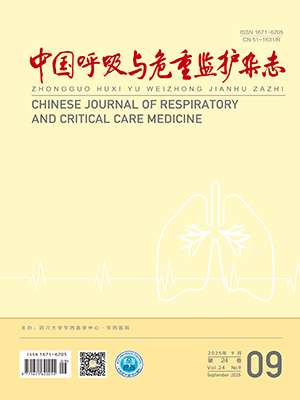Objective To analyze the data from patients with pathologically proved granulomatous lung disease, including etiology, clinical, radiological features and laboratory results.
Methods 36 patients with granulomatous lung disease confirmed by lung biopsy in Shanghai First People’s Hospital of Shanghai Jiao Tong University from January 2008 to June 2012 were retrospectively reviewed. The clinical presentation, radiological features and laboratory results were collected and statistically analyzed.
Results After haematoxylin and eosin stain combined with special stain, the diagnoses were comfirmed, ie.13 cases of mycobacterial infection, 5 cases of aspergillar infection, 4 cases of cryptococcal infection, 6 cases of sarcoidosis, 4 cases of Wegener’s granulomatosis, 4 cases of unknown causes. Cough was the most common clinical symptom, followed by expectoration. Some patients also developed fever, chest tightness and weight loss. The lesions were widely distributed, of which the right upper lung was the common lesion of mycobacterial infection, inferior lobe of right lung was the common lesion of aspergillar infection. The common lesion of cryptococcal infection was uncertain. The common lesions of sarcoidosis and Wegener ’s granulomatosis were in left upper lung. Small nodule was the most common shapes of lesion, while mass and consolidation were present sometimes. Cavity, air bronchogram, pleural effusion, hilar and mediastinal lymph node enlargement could be found in the chest CT. Interferon gamma release assay, galactomannan antigen assay and latex agglutination test were helpful in the diagnosis of mycobacterial infection, aspergillar infection and cryptococcal infection induced granuloma.
Conclusions The clinical presentations and radiological features of granulomatous lung disease are nonspecific. Histopathology obtained through biopsy is the key for the diagnosis. Immunological examination, test of new antigens to microorganism and clinical microorganism detection are valuble in the diagnosis and differential diagnosis of granulomatous lung disease.
Citation: LI Feng,CHEN Yuqing,BAO Aihua,ZHOU Xin.. Clinical Analysis of Granulomatous Lung Disease: 36 Cases Report. Chinese Journal of Respiratory and Critical Care Medicine, 2013, 12(3): 274-278. doi: 10 . 7507 /1671 -6205 . 20130065 Copy
Copyright © the editorial department of Chinese Journal of Respiratory and Critical Care Medicine of West China Medical Publisher. All rights reserved




